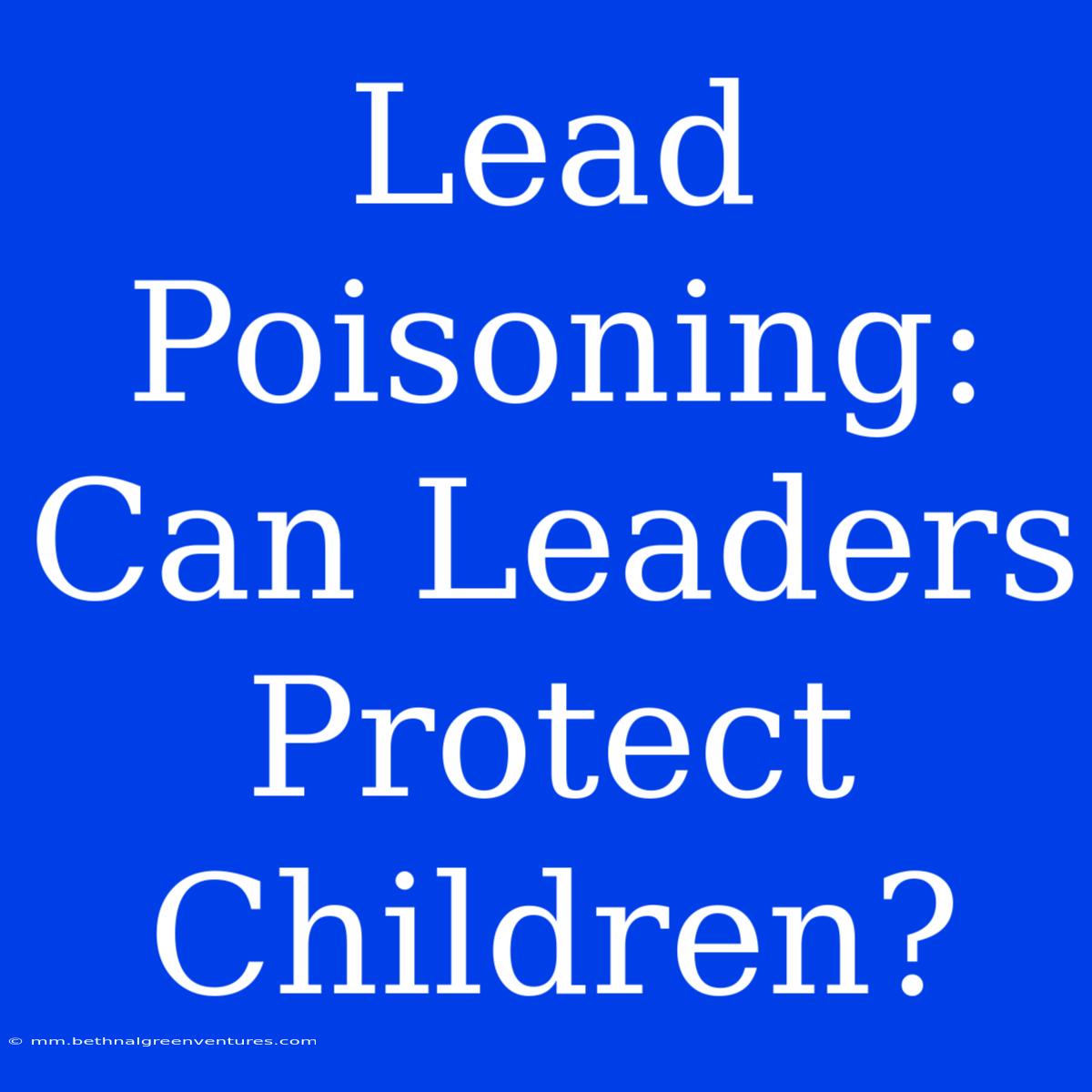Lead Poisoning: Can Leaders Protect Children?
Can leaders effectively protect children from lead poisoning? This is a question that has plagued communities worldwide for decades. The answer is complex and requires a multifaceted approach, but the potential for progress is undeniable.
Editor Note: Lead poisoning remains a significant public health concern, especially for children. This article explores the critical role of leadership in mitigating this threat and offers insights for a safer future.
The severity of lead poisoning cannot be overstated. Even small amounts of lead can lead to irreversible damage, impacting a child's cognitive development, behavior, and overall well-being. Recognizing this, it becomes imperative to understand how leaders can act as catalysts for change.
Analysis: This article delves into the issue of lead poisoning, examining the crucial role of leadership in safeguarding children. We've researched the causes, impacts, and mitigation strategies, drawing upon evidence-based practices and expert insights. This guide aims to equip readers with knowledge and understanding to advocate for children's health and well-being.
Key Takeaways on Lead Poisoning:
| Aspect | Explanation |
|---|---|
| Causes: | Lead exposure can occur through contaminated water, paint, soil, and dust. |
| Impacts: | Lead poisoning can cause developmental delays, learning disabilities, behavioral problems, and even death. |
| Vulnerability: | Children are particularly vulnerable to lead poisoning due to their rapid growth and development. |
| Mitigation: | Preventing lead exposure through proactive measures like lead paint testing, safe water practices, and environmental cleanup is vital. |
Lead Poisoning
Introduction: Addressing lead poisoning requires a comprehensive approach that acknowledges the diverse factors contributing to this public health crisis. Leadership plays a pivotal role in driving policy changes, resource allocation, and community engagement.
Key Aspects of Lead Poisoning:
- Environmental Factors: Contaminated water, soil, and air can expose children to lead.
- Housing Conditions: Old lead paint, crumbling infrastructure, and lack of proper maintenance can create hazardous environments.
- Social Determinants of Health: Poverty, lack of access to healthcare, and inadequate housing all contribute to vulnerability.
- Policy and Regulations: Effective lead-safe policies and regulations are crucial for prevention.
- Public Awareness: Educating the public about the risks of lead poisoning and promoting prevention strategies is essential.
Discussion:
Environmental Factors: Understanding the sources of lead contamination is crucial. This involves testing water, soil, and air to identify hotspots. It requires the leadership to invest in infrastructure improvements and remediation efforts.
Housing Conditions: Leadership must actively address unsafe housing conditions by promoting lead-safe renovations and encouraging landlords to comply with safety regulations. Providing resources for low-income families to make their homes lead-safe is equally important.
Social Determinants of Health: Leaders need to prioritize addressing poverty, improving access to healthcare, and ensuring affordable housing. By investing in these areas, they can create a safer environment for children and address the root causes of lead poisoning vulnerability.
Policy and Regulations: Effective policy and regulation are vital. This includes setting strict lead standards for paint, water, and soil, enforcing building codes, and establishing a robust lead testing and remediation program.
Public Awareness: Leaders must invest in public awareness campaigns that educate communities about the dangers of lead poisoning, provide practical tips on preventing exposure, and encourage regular lead testing.
FAQs by Lead Poisoning
Introduction: This section answers frequently asked questions about lead poisoning, providing clarity and addressing common concerns.
Questions:
-
What are the symptoms of lead poisoning?
- Symptoms can include developmental delays, learning difficulties, behavior problems, fatigue, headaches, and abdominal pain.
-
How can I test my child for lead poisoning?
- A simple blood test can detect lead levels in a child's blood.
-
What are the best ways to prevent lead poisoning?
- Prevent lead exposure by testing for lead paint, ensuring safe water practices, and regularly cleaning surfaces.
-
What should I do if I suspect my child has been exposed to lead?
- Consult with your pediatrician immediately and discuss lead testing.
-
Who is responsible for ensuring a lead-safe environment for children?
- It is a shared responsibility, encompassing government agencies, landlords, parents, and community members.
-
How can I get involved in advocating for children's health and safety?
- Support organizations working to prevent lead poisoning, advocate for stricter regulations, and raise awareness in your community.
Summary: Lead poisoning is a serious threat to children's health and development. By understanding the causes, impacts, and prevention strategies, leaders can play a vital role in protecting children and ensuring a safer future.
Tips of Lead Poisoning
Introduction: These practical tips offer guidance on reducing lead exposure and creating a lead-safe environment for children.
Tips:
-
Test your home for lead paint. If you have a pre-1978 home, it's important to get it tested for lead paint.
-
Ensure your water is lead-free. Use a certified lead-free filter or run the cold water for several minutes before drinking or cooking.
-
Keep your home clean. Dusting and vacuuming regularly can help remove lead dust from surfaces.
-
Wash your hands frequently. Washing hands after playing outdoors, gardening, and before meals can prevent lead exposure.
-
Monitor your child's development. If you notice developmental delays or behavioral changes, consult a healthcare professional.
-
Advocate for change. Support organizations working to prevent lead poisoning and encourage stricter regulations.
Summary of Lead Poisoning
Summary: Lead poisoning is a preventable public health crisis. Leaders have a crucial role to play in protecting children from this threat by implementing effective policies, promoting public awareness, and ensuring safe environments.
Closing Message: By working together, leaders, communities, and individuals can build a future where children are free from the devastating effects of lead poisoning. It is a collective responsibility to prioritize their well-being and create a healthier, safer world for all.
